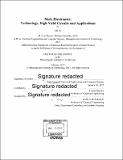| dc.contributor.advisor | Tomás Palacios. | en_US |
| dc.contributor.author | Yu, Lili, Ph. D. Massachusetts Institute of Technology | en_US |
| dc.contributor.other | Massachusetts Institute of Technology. Department of Electrical Engineering and Computer Science. | en_US |
| dc.date.accessioned | 2017-05-11T19:59:36Z | |
| dc.date.available | 2017-05-11T19:59:36Z | |
| dc.date.copyright | 2017 | en_US |
| dc.date.issued | 2017 | en_US |
| dc.identifier.uri | http://hdl.handle.net/1721.1/108993 | |
| dc.description | Thesis: Ph. D., Massachusetts Institute of Technology, Department of Electrical Engineering and Computer Science, 2017. | en_US |
| dc.description | Cataloged from PDF version of thesis. | en_US |
| dc.description | Includes bibliographical references (pages 177-186). | en_US |
| dc.description.abstract | In the last few decades, the device community has explored a large number of technologies beyond silicon, that not only allow for further shrinkage in electronic systems size and power but can also provide new features, such as mechanical flexibility, large-area coverage at low cost thanks to inkjet printing, and simplified 3D integration. Two-dimensional electronics based on single-layer MoS₂ synthesized by chemical vapor deposition (CVD) offers significant advantages for realizing large-scale flexible systems owing to the ultrathin nature, excellent transport properties and stable crystalline structure of MoS₂. Despite all the progress, the MoS₂ electronics demonstrated so far is limited to single or few-device- scale circuits built on exfoliated flakes due to the many challenges associated with the uniformity and yield control in both material growth and device technologies. This thesis addresses issues which are crucial for realizing reliable, and high-yield complex circuits using emerging 2D materials, such as MoS₂: (1) Develop large-area material synthesis and transfer methods, as well as some of the first technologies for reliable enhancement mode MoS₂ transistors. (2) Design an automatic flow for fast implementation of complex circuits using MoS₂.Compact models and a process development kit (PDK) are developed for MoS₂ and are used to successfully implement both digital and analog circuits. (3) Study the sources of variability in MoS₂ devices and circuits and improve circuits yield by material, process, and device and circuit design co-optimization. (4) Demonstrate two system-level applications of CVD MoS₂: active matrix backplane circuits for transparent displays and radio frequency energy harvester. (5) Demonstrate the first air-stable CMOS technology monolithically integrated on WSe₂ to offer low power electronic solution. The future opportunities and potential challenges for all these technologies are also discussed. This thesis, in summary, provided important guidelines on how to take a new proof-of-concept material/device and make it into a useful technology to enable practical applications. | en_US |
| dc.description.statementofresponsibility | by Lili Yu. | en_US |
| dc.format.extent | 4, xii, 186 pages | en_US |
| dc.language.iso | eng | en_US |
| dc.publisher | Massachusetts Institute of Technology | en_US |
| dc.rights | MIT theses are protected by copyright. They may be viewed, downloaded, or printed from this source but further reproduction or distribution in any format is prohibited without written permission. | en_US |
| dc.rights.uri | http://dspace.mit.edu/handle/1721.1/7582 | en_US |
| dc.subject | Electrical Engineering and Computer Science. | en_US |
| dc.title | MoS₂ electronics : technology, high yield circuits and applications | en_US |
| dc.title.alternative | Technology, high yield circuits and applications | en_US |
| dc.type | Thesis | en_US |
| dc.description.degree | Ph. D. | en_US |
| dc.contributor.department | Massachusetts Institute of Technology. Department of Electrical Engineering and Computer Science | |
| dc.identifier.oclc | 986522190 | en_US |
